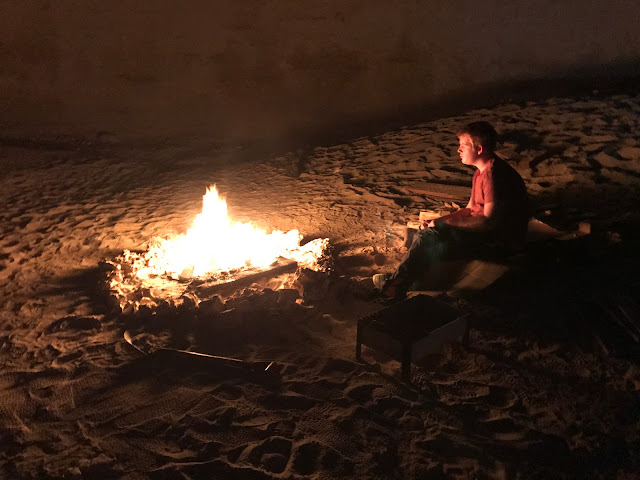 | ||
In the Zekreet area of Qatar where there are amazing rock formations, a tranquil, emerald sea, and endless sands in all directions. You feel far from the world, and almost expect a caravan of travelers to ask for water from your oasis.
|
 |
| At a recent campout that my husband and son went on in Zekreet, Qatar |
In a desert region one day, a number of travelers set out on a trip. It was hot and the journey was long. They had little in common except their shared desire to arrive at a distant city. Each carried provisions and water expecting to replenish their supplies along the way. Not long after leaving their homes, a great storm arose. Dust clouds darkened the sun, and the wind brought swirling sands which quickly filled the low places in the road. What at first had seemed a pleasant outing suddenly became a hazardous undertaking. The travelers soon realized that the question was not merely when they would arrive at the city, but whether they would arrive at all.
Confusion and doubt affected the company. Some sought shelter, while others attempted to turn back. A few moved onward through the storm. The end of the first day found them scattered, with inadequate provisions, wanting water, and lost in the desert. A new day brought hunger, thirst, and despair. The storm still raged. Hope was in short supply. Familiar landmarks were gone. The road, which had been narrow and hard to find, at best, was hidden by silt and debris. No one knew where to go to find it. Many claimed to know the way, but as they could not agree, each traveler wandered in his own way in search of water or the shelter of a settlement.
At the end of yet another day, two of the group, half-blinded by dust and with their strength nearly gone, came unexpectedly, with something more than good fortune, upon an inn and way station. There in the sanctuary of walls and roof, they refreshed themselves and counted their blessings. There they replenished their stores and contemplated the remaining portion of their journey. The weather remained unsettled. The wind continued to blow. The poorly marked road wound ahead through hills where the sand piled deep and where it was said that robbers sometimes preyed upon unsuspecting travelers.
 |
| Keep your fire burning bright on the journey. |
One of the two was anxious to reach his destination. He had important business in the city. He gathered his supplies and water and paid his account. Early in the morning he set out in haste in an attempt to cross the hill country by nightfall. But the windblown sand had blocked the road. He was forced to dig and detour. When night came, he was far from the city, exhausted and alone. When he fell asleep, thieves found him, took his supplies, and left him without strength and without water to face almost certain death.
The second traveler was also desirous of reaching his destination. But he remembered the others in the desert behind him. They were lost and would soon perish without water and without hope. He alone knew where they were. He alone knew their condition and their need. He likewise arose early and paid his account. He glanced at the hills with their promise of the city beyond, and then turned back down the road whence he had come. The sky was a little lighter now. He recognized some of the landmarks. He knew about where he had left his traveling companions. He called out to them by name, for he knew them. After hours of patient searching, he found many of them. He shared with them life-giving water from his own containers. He told them he knew the way. He spoke as if he had authority, so they followed him, and he brought them to the way station with him. There they rested and regained their strength. They were given directions regarding how to reach the city. They renewed their provisions, filled their water containers, and went out again to face the storm.
The journey was still difficult. The wind still blew and clouds obscured the sun. The road still wound through the sometimes deep sand, and thieves were still in the hills. But this time the traveler was not alone. The group was large. When sand blocked the way, work parties were organized to remove it. When some faltered, the strong shouldered the burdens of the weak. When night came, there were watchmen to man the watch. After many days, the second man and his friends arrived safely at their destination.
The journey was still difficult. The wind still blew and clouds obscured the sun. The road still wound through the sometimes deep sand, and thieves were still in the hills. But this time the traveler was not alone. The group was large. When sand blocked the way, work parties were organized to remove it. When some faltered, the strong shouldered the burdens of the weak. When night came, there were watchmen to man the watch. After many days, the second man and his friends arrived safely at their destination.
When they arrived there, those who had been rescued and given water gathered around the second traveler and said, “We could not have come to this place without you. We shall ever be grateful to you for searching for us, for finding us, for sharing your water and your bread. We know that you put aside your own journey and submitted to the hardships of the desert in order to help us when we were lost. What can we do to repay you?”
















